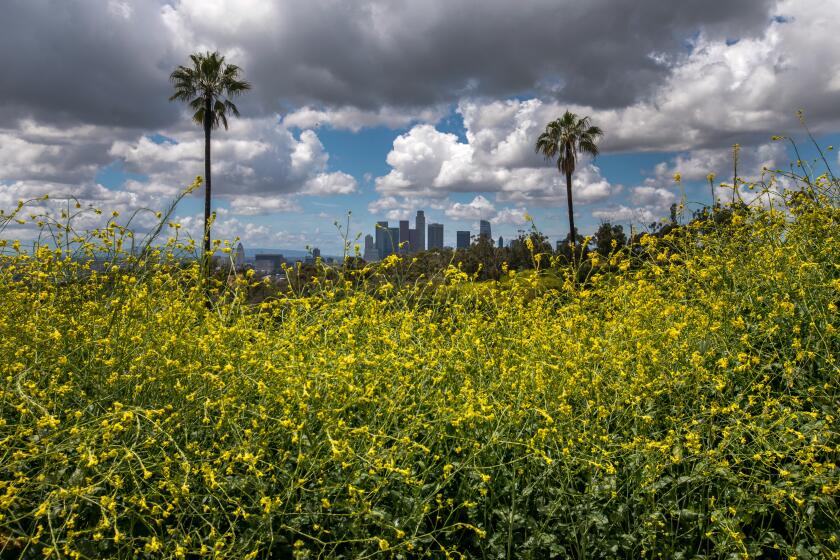Op-Ed: How strong is ‘disaster culture’ in earthquake-prone L.A.?
The swarm of temblors in late September beneath the Salton Sea put Los Angeles on heightened alert and caused public officials to remind Angelenos about stockpiling water, shutting off gas valves, and remembering to “drop and cover.” The message is familiar: Although the agent is natural in disasters like earthquakes, the catastrophe that follows is all too human and unnatural. Its severity depends entirely on how well the city prepares, how strong a “disaster culture” it has built.
In L.A., such a culture took a while to get going. A hundred years ago, L.A. was promoting itself as a city free from earthquakes, with businesses relocating south after San Francisco’s 1906 destruction by earthquake and fire.
Then the 1925 Santa Barbara earthquake threatened the promised seismic calm. In 1928 the Chamber of Commerce commissioned a local geologist to write a reassuring book, “Southern California Geology and Los Angeles Earthquakes,” in which he identified the region’s faults one by one, then dismissed them as “inactive.” Of the Inglewood Fault, he noted, “it cannot be said there is any great menace.” Five years later, that fault ruptured in the 1933 Long Beach earthquake, magnitude 6.4 on the Richter scale.
The Long Beach earthquake ended the campaign of earthquake denialism in Southern California.
The Long Beach quake proved something of a game changer. In the early evening shock, many school buildings collapsed. It was estimated that 6,000 children could have been killed if the earthquake had happened an hour earlier. Thirty days later, the Legislature passed the state’s first-ever bill requiring that the design and construction of public school buildings be regulated by structural engineers acting for the state.
The Long Beach earthquake ended the campaign of earthquake denialism in Southern California. Subsequent quakes big and small — especially Sylmar (1971, 6.6) and Northridge (1994, 6.7) — provided engineers and seismologists at CalTech, UC, Cal State and USC with copious data about what happens to city infrastructure when the earth moves. Building codes for new structures were updated; old brick buildings were strengthened. Insurance companies encouraged homeowners to bolt foundations and replace brick fireplaces. But it took until 2015 for Los Angeles to demand that property owners reinforce thousands of dangerous old concrete buildings and “soft story” wood-frame apartments — even after some 65 people died in such buildings in ’71 and ’94.
So if you were scoring the city for its earthquake preparedness you would give it high marks for technical expertise. That isn’t enough to combat the earthquake threat. You need disaster culture.
To find a model disaster culture, go Dutch. Over centuries, the people of the Netherlands took ownership of the wild and dangerous floods they called the “water wolf.” Life and death in the Rhine River delta depended on how well they managed water. They developed a system in which every village had a water guardian, and the guardians coordinated their activities in regional agencies. Meanwhile the ruling prince provided the money and manpower to defend the threatened coastline with wave-resistant embankments and secondary lines of defense. All villagers were on call to fight a dike breach. They developed new technologies, such as windmills to raise water, allowing land to be reclaimed. The Dutch showed how leadership, funding and communal ownership made it possible to master living below sea level. As they boasted in the mid-1500s, shortly before the Dutch Golden Age: “God made the World, but the Dutch made Holland.” That attitude survives in the Netherlands today.
What Holland created — a national narrative of resilience, shared by all the people — is what L.A. (and every city threatened by natural disaster) should aspire to. Today, with the power of information technology and education, it won’t take centuries to evolve.
Despite its slow beginnings, Los Angeles has laid a foundation for its disaster culture. Nearly 5 million Southern Californians are registered to participate in the 8th annual Great Shakeout earthquake drill on October 20. The Shakeout website has manuals, reports and interactive maps that explain how to prepare for a magnitude 7.8 quake on the southern San Andreas fault, and what the aftermath will be like.
In 2014, Mayor Eric Garcetti appointed seismologist Lucy Jones as the L.A. earthquake czar. In a detailed report and at meetings with businesses and civic groups, she underlined the hard facts: thousands of buildings could collapse in greater Los Angeles, cell phones, water and power would be cut off for weeks; 2,000 people might die. Her work, reinforced by engineering reports from UC and Cal State and investigations by The Times, is what pushed the city to mandate a retrofit of dangerous concrete and wood-frame buildings in L.A.
Now L.A. should make “earthquake czar” a permanent position. The city could follow the lead of the Netherlands in setting a legal target level of risk. Or it could look to Tokyo, which has set a goal of reducing its disaster casualties (estimated using independent risk modeling) by 50% over the next few years. Major corporations are putting in place “platinum” resilience standards for a range of disasters; the goal is a return to full operation within 72 hours. If businesses can do it, so can L.A.
It is not by accident that Los Angeles is situated where it is: a fabulous location on a coastal plain next to mountains formed by an adjacent tectonic plate boundary. Earthquakes — big ones — come with the territory. Yet it’s entirely possible the city could one day ride out even the greatest of shocks, just as Holland survives rising seas and the latest winter storm.
Robert Muir-Wood is chief research officer of Risk Management Solutions, and author of “‘The Cure for Catastrophe: How We Can Stop Manufacturing Natural Disasters.”
Follow the Opinion section on Twitter @latimesopinion and Facebook
More to Read
A cure for the common opinion
Get thought-provoking perspectives with our weekly newsletter.
You may occasionally receive promotional content from the Los Angeles Times.






